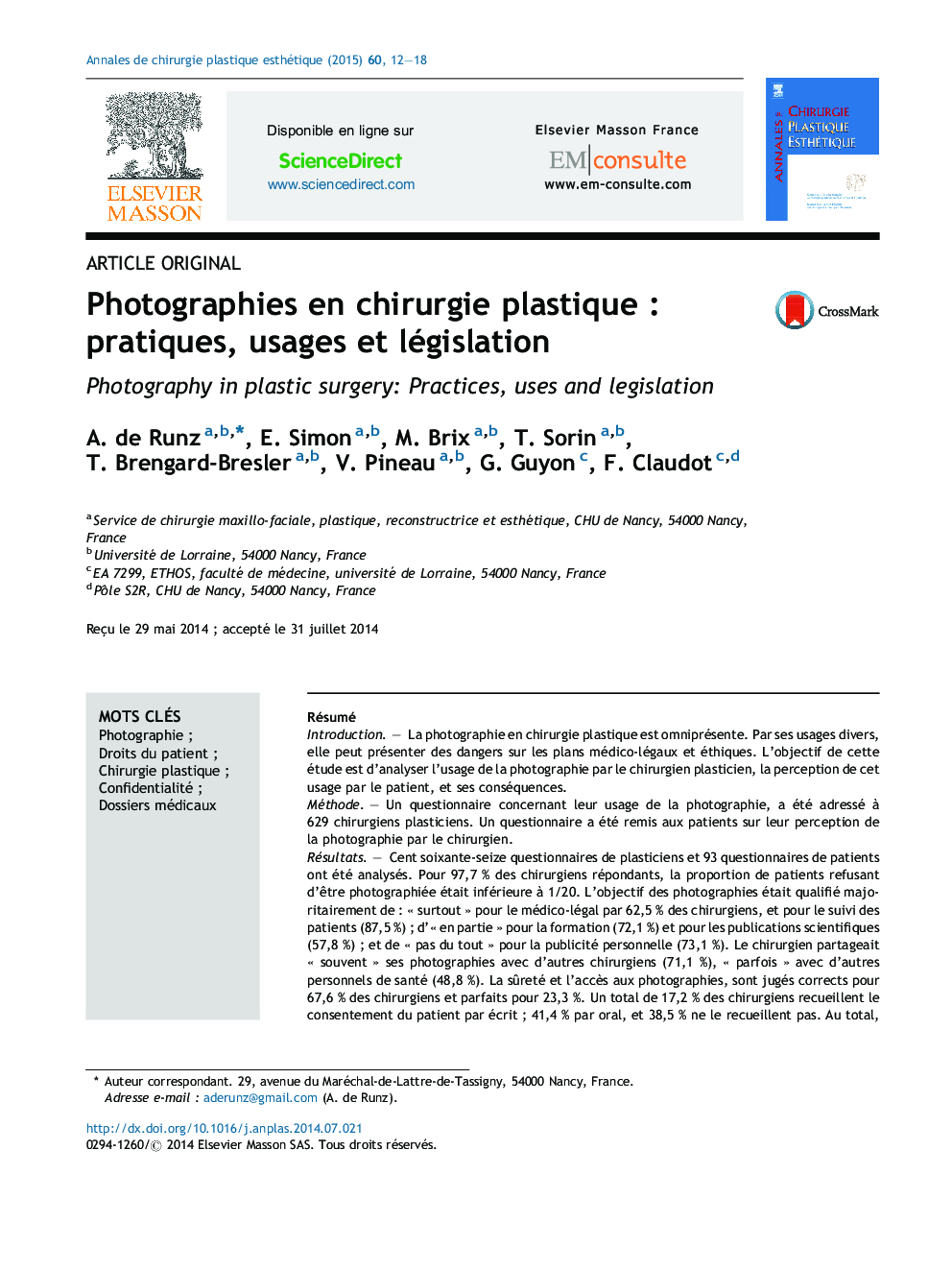| Article ID | Journal | Published Year | Pages | File Type |
|---|---|---|---|---|
| 3184573 | Annales de Chirurgie Plastique Esthétique | 2015 | 7 Pages |
RésuméIntroductionLa photographie en chirurgie plastique est omniprésente. Par ses usages divers, elle peut présenter des dangers sur les plans médico-légaux et éthiques. L’objectif de cette étude est d’analyser l’usage de la photographie par le chirurgien plasticien, la perception de cet usage par le patient, et ses conséquences.MéthodeUn questionnaire concernant leur usage de la photographie, a été adressé à 629 chirurgiens plasticiens. Un questionnaire a été remis aux patients sur leur perception de la photographie par le chirurgien.RésultatsCent soixante-seize questionnaires de plasticiens et 93 questionnaires de patients ont été analysés. Pour 97,7 % des chirurgiens répondants, la proportion de patients refusant d’être photographiée était inférieure à 1/20. L’objectif des photographies était qualifié majoritairement de : « surtout » pour le médico-légal par 62,5 % des chirurgiens, et pour le suivi des patients (87,5 %) ; d’« en partie » pour la formation (72,1 %) et pour les publications scientifiques (57,8 %) ; et de « pas du tout » pour la publicité personnelle (73,1 %). Le chirurgien partageait « souvent » ses photographies avec d’autres chirurgiens (71,1 %), « parfois » avec d’autres personnels de santé (48,8 %). La sûreté et l’accès aux photographies, sont jugés corrects pour 67,6 % des chirurgiens et parfaits pour 23,3 %. Un total de 17,2 % des chirurgiens recueillent le consentement du patient par écrit ; 41,4 % par oral, et 38,5 % ne le recueillent pas. Au total, 48,3 % des chirurgiens et 40,2 % des patients pensent que les droits de la photographie appartiennent au patient.ConclusionLa photographie expose le chirurgien plasticien à des risques médico-légaux. Il se doit alors de connaître la loi et ainsi pouvoir se prémunir contre d’éventuelles poursuites judiciaires.
SummaryIntroductionPhotography in plastic surgery is omnipresent. Through its various uses, it may present both ethical and forensic risks. The objective of this study is to analyze the use of medical photography by the plastic surgeon, the perception of this use by the patient, and consequence of such use.MethodA questionnaire about the use of medical photography was assessed to 629 plastic surgeons. A questionnaire was given to patients, about their perception of the use of photography by their surgeon.ResultsOne hundred and seventy-six surgeon's questionnaires and 93 patient's questionnaires were analyzed. For 97.7% of the responding surgeons, the proportion of patients refusing to be photographed was less then 1/20. The objective of the photography was especially medicolegal for 62.5% of the surgeons, especially for following the patient progress (87.5%), partially for the formation (72.1%), partially for scientific publications (57.8%) and not at all for the personal publicity (73.1%). Surgeons often share his photographs with others surgeons (71.1%), sometimes with others medical personnel (48.8%). The security and the access to photographs were determined to be correct for 67.6% of the surgeons and perfect for 23.3%. In total, 17.2% of the surgeons obtained a written consent, 41.4% obtained an oral consent, and 38.5% did not request patient consent. It was found that 48.3% of the surgeons and 40.2% of the patients think that the right to the photographic images belong to the patient.ConclusionMedical photographs expose the plastic surgeon to medico-legal risks. He must know and follow the law in order to prevent eventual legal proceedings.
